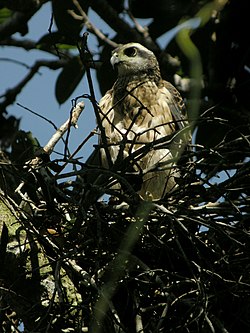| True hawks | |
|---|---|
 | |
| Sharp-shinned hawk | |
| Scientific classification | |
| Kingdom: | Animalia |
| Phylum: | Chordata |
| Class: | Aves |
| Order: | Accipitriformes |
| Family: | Accipitridae |
| Subfamily: | Accipitrinae |
| Genera | |
11 genera. See below. | |

The Accipitrinae are the subfamily of the Accipitridae often known as the "true" hawks. The subfamily contains 73 species that are divided into 11 genera. It includes the genus Accipiter which formerly included many more species. The large genus was found to be non-monophyletic and was split into several new or resurrected genera. The birds in this subfamily are primarily woodland birds that hunt by sudden dashes from a concealed perch, with long tails, broad wings and high visual acuity facilitating this lifestyle.
Contents
Hawks, including the accipitrines, are believed to have vision several times sharper than humans, in part because of the great number of photoreceptor cells in their retinas (up to 1,000,000 per square mm, against 200,000 for humans), a very high number of nerves connecting the receptors to the brain, and an indented fovea, which magnifies the central portion of the visual field. Eagles, such as the bald eagle in the family Buteoninae, are also included in this family.
A series of molecular phylogenetic studies found that the genus Accipiter was non-monophyletic. [1] The results of a densely sampled 2024 study of the Accipitridae allowed the generic boundaries to be redefined. [2] To create monophyletic genera, species were moved from Accipiter to five new or resurrected genera leaving only 9 species in Accipiter. [3] The southeast Asian crested goshawk and the Sulawesi goshawk were found to be only distantly related to other species in Accipiter. They were moved to a resurrected genus Lophospiza , the only genus placed in the new subfamily Lophospizinae. Similarly, the very small south America tiny hawk and semicollared hawk were found to be only distantly related to species in Accipiter. They were moved to a newly erected genus Microspizias which together with Harpagus is placed in the subfamily Harpaginae. The genera Circus , Megatriorchis , and Erythrotriorchis were found to be nested within Accipiter. Rather than subsuming these genera into an expanded Accipiter, species were moved from Accipiter to the resurrected genera Aerospiza , Tachyspiza and Astur . [3]
The genus level cladogram of the Accipitrinae shown below is based on a molecular phylogenetic study of the Accipitridae by Therese Catanach and collaborators that was published in 2024. [2] The number of species in each genus is based on the list maintained by Frank Gill, Pamela C. Rasmussen and David Donsker on behalf of the International Ornithological Committee (IOC). [3]
| Accipitrinae |
| ||||||||||||||||||||||||||||||||||||||||||||||||||||||||||||










